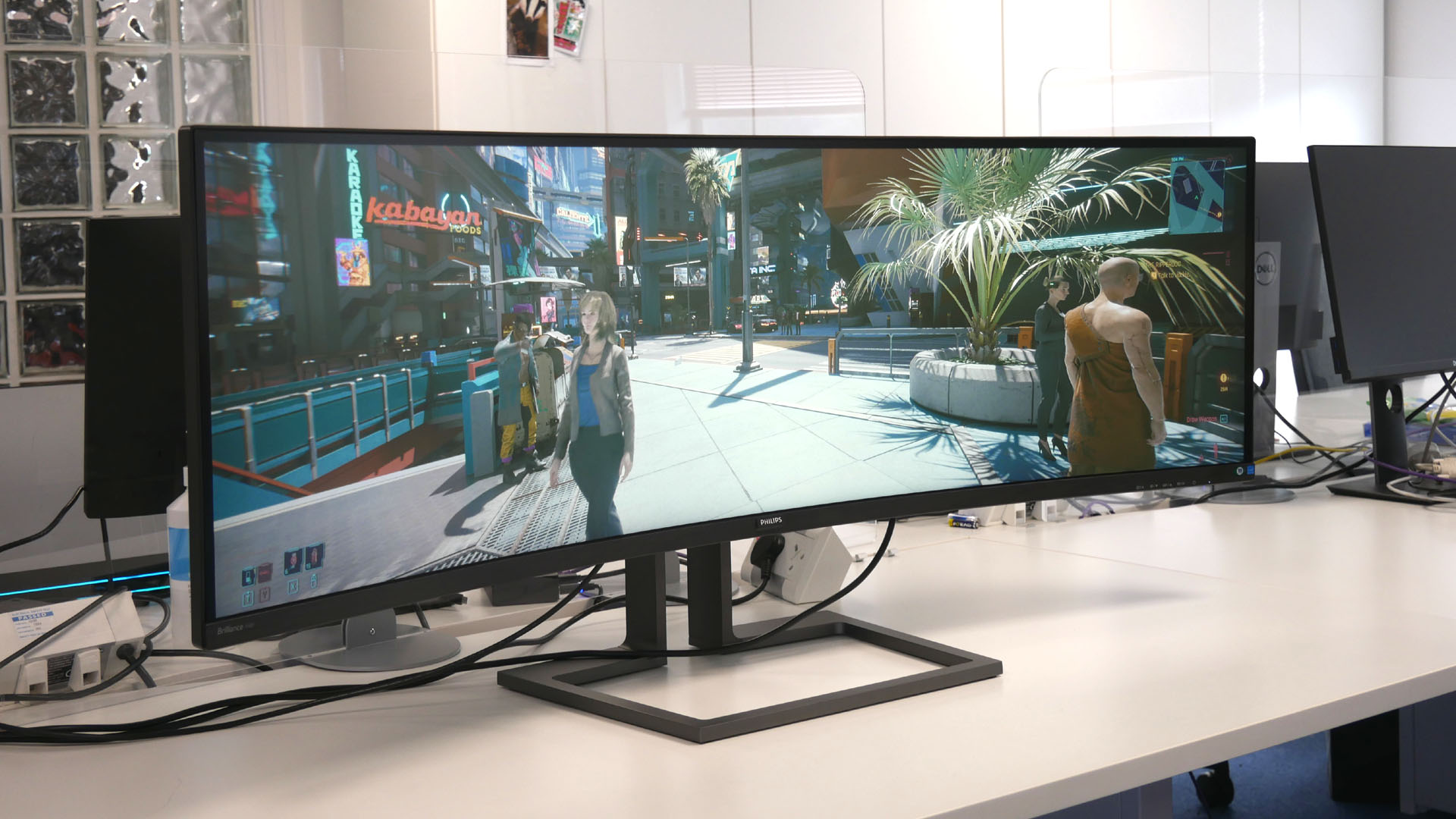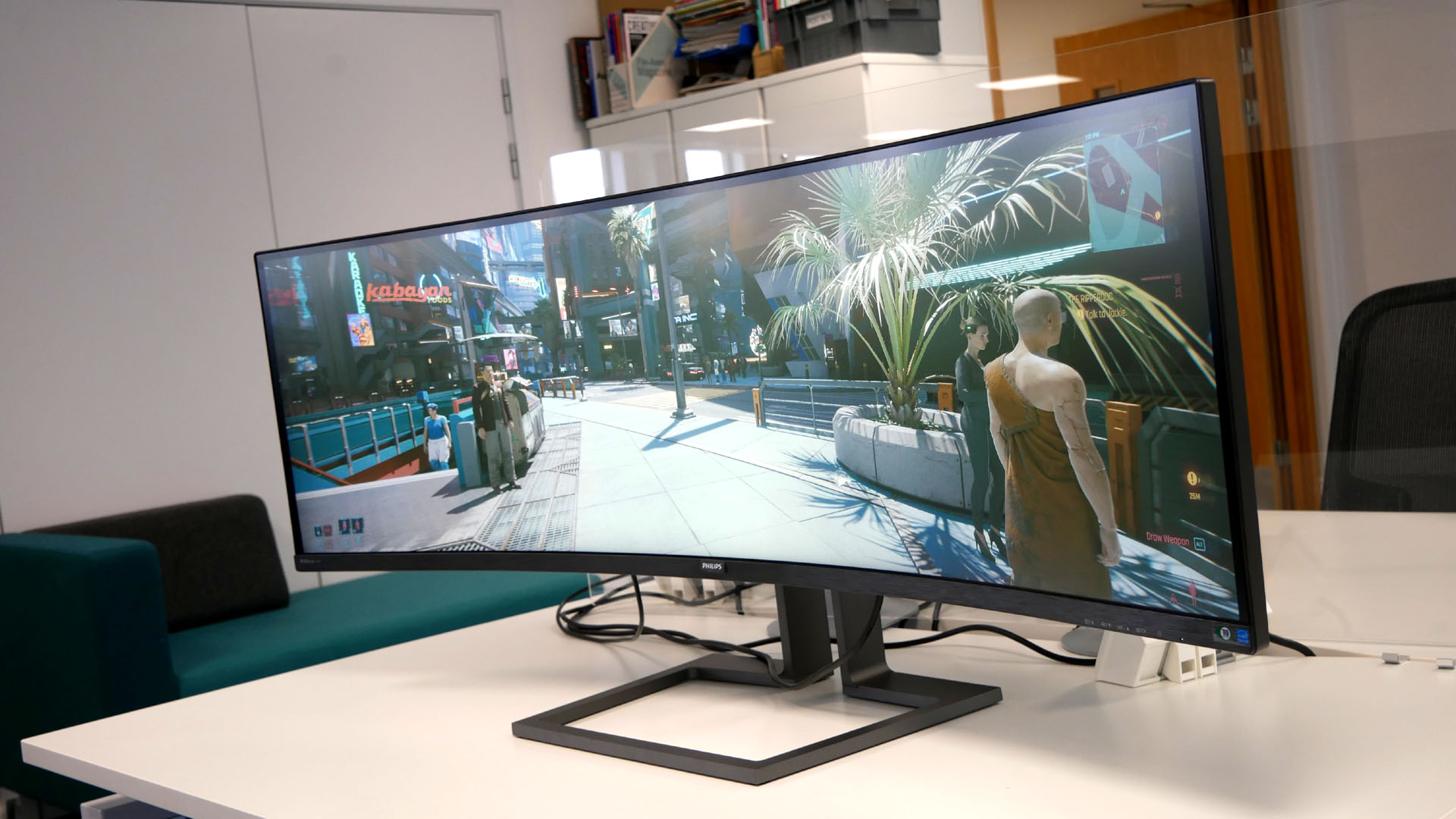Our Verdict
If big is beautiful, the Philips Brilliance 498P9Z is a stunner. The combination of an epic 49-inch panel with a 165Hz refresh makes for incredible gaming immersion, even if HDR support is limited.
For
- Monster 49-inch panel
- Zippy 165Hz refresh
- Excellent contrast from the VA panel
Against
- Pixel response is only decent
- Limited HDR support
- Pixel density isn’t all that
PC Gamer's got your back
What to make of the epic Philips Brilliance 498P9Z? It’s not entirely unfamiliar. In fact, hack the ‘Z’ off the end and you have the Philips Brilliance 498P9, an ostensibly identical monitor that rolled out nearly two years ago.
Identical, that is, save for one critical difference. The new Z model adds high refresh to the package, all 165Hz of it, where the existing model topped out at 60Hz. And what an existing package that was and continues to be.
The basic numbers are a bit bonkers. The huge 49-inch panel is formatted to an almost ridiculously wide 32:9 aspect ratio. You get 5,120 by 1,440 pixels and a punchy peak brightness of 550 nits. Actually, that latter figure is also an upgrade over the non-Z, which tops out at 450 nits.
The panel’s inherent contrast remains 3,000:1, which immediately tells you this is a VA rather than an IPS monitor. Even LG’s very latest IPS Black panel is only good for a claimed 2,000:1 contrast. VA panels aren’t typically renowned for their speedy responses, so the 498P9Z’s 4ms rated response performance isn’t a huge surprise. But it is some distance off current 1ms IPS technology.
As for other panel attributes, the Z's claimed coverage of the AdobeRGB gamut has actually dropped off a couple of points to 89%. DCI-P3 coverage, which is arguably more relevant for what has become a more gaming-centric monitor, is 91%, which is middling. It takes 95% and up to impress us, these days.
Philips has also added HDR support for this revised model. But it’s the basic DisplayHDR 400 variety, so don’t get too excited. There’s no local dimming, no fancy mini-LED backlight. That said, the superior contrast of a VA panel never hurts when it comes to improving dynamic range.

Screen size: 49-inch
Panel type: VA
Resolution: 5,120 x 1,440
Brightness: 550 nits
Contrast: 3,000:1
Response time: 4ms
Refresh rate: 165Hz
Colour coverage: 91% DCI-P3
HDR support: Vesa DislayHDR 400
Connectivity: DisplayPort 1.4 x1, HDMI 2.0 x3
Price: £999
As for connectivity, well, the single DisplayPort 1.4 socket is the only way to get that 165Hz refresh going. The three HDMI ports are only 2.0 spec. You need HDMI 2.1 to drive a display with this many pixels at high refresh rates. A four-port USB hub rounds out the connectivity. In other words, you don’t get USB Type-C. Philips does actually offer a very similar panel with USB Type-C ports if that’s important to you, the 499P9H. But that’s a 60Hz panel. So take your pick. High refresh or USB Type-C. You can’t have both.
Anyway, fire the Philips Brilliance 498P9Z up and it’s immediately obvious how punchy it is. This may not be a true HDR display. But the combination of that 550 nit backlight power with the excellent contrast of a VA panel really sizzles. A ray-traced graphics fest like Cyberpunk 2077 is truly spectacular on a panel of this scale with this much zing.
That said, it’s not obvious that the 498P9Z actually looks any better running games like Cyberpunk in HDR rather than SDR mode. What we can say confidently is that SDR content looks like trash in HDR mode. So, you’ll need to toggle HDR mode as and when rather than leave it on all the time. That’s a bit tiresome, albeit a common fault among monitors with low-end HDR support.
In a broader gaming context, the crazy 32:9 aspect has pros and cons. For immersion, it’s stellar. Having pretty much all your peripheral vision filled makes a real difference. But the extreme aspect can also be problematic. Most competitive online games, like say Fortnite, cap your field of view to prevent ultrawide panels from providing an unfair advantage. The result is suboptimal: a very obviously stretched image.
Your mileage will vary with other game genres. Much depends on how flexible a given game is with the location and configuration of persistent on-screen features like menus and status bars, along with the aforementioned FoV issues.
What’s consistent for all games is the relatively low pixel density. No question, 5,120 by 1,440 is a whole lotta pixels. At 7.4 million, it’s not far off the 8.3 million pixels of full 4K. But stretched over such a large screen it only makes for 109 pixels per inch. A 4K 32-inch monitor, by way of example, is around 140PPI.

So, you don’t get that razor-sharp image quality, that photorealistic detail, that’s characteristic of smaller 4K screens. Arguably, that’s even more of an issue on the Windows desktop, where the low pixel density isn’t exactly the stuff of crispy fonts and icons, even if the huge panel does make for some serious multitasking clout.
You also don’t get the sheer speed of the best IPS monitors. For sure, the 165Hz refresh means that the 498P9Z feels slick and responsive (provided you have a very fast GPU to drive all seven million pixels at over 100fps). But the actual pixel response is only decent rather than excellent.
All told, the Philips Brilliance 498P9Z doesn’t get a lot wrong. It has some inherent limitations that stem from its size, resolution, aspect ratio, and panel type. But then it also benefits directly from all those elements.
At its best, the 498P9Z is undoubtedly spectacular. But it’s not alone in this part of the market. At £999 in the UK (for now, US pricing isn’t available), it has plenty of competition including the very similar and very slightly cheaper AOC AGON AG493UCX2. Samsung’s first-gen G9 can also now be had for around £300 more and offers better response, even more punch and that extreme wrap-around curve. These kinds of screens are all a lot of money. But then they’re all an awful lot of monitor, too.
If big is beautiful, the Philips Brilliance 498P9Z is a stunner. The combination of an epic 49-inch panel with a 165Hz refresh makes for incredible gaming immersion, even if HDR support is limited.

Jeremy has been writing about technology and PCs since the 90nm Netburst era (Google it!) and enjoys nothing more than a serious dissertation on the finer points of monitor input lag and overshoot followed by a forensic examination of advanced lithography. Or maybe he just likes machines that go “ping!” He also has a thing for tennis and cars.


